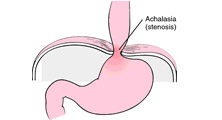Achalasia Surgery

The esophagus has three functional parts which are upper esophageal sphincter, main part of the esophagus, and lower esophageal sphincter. Upper esophageal sphincter separates the esophagus from the throat and prevents food in the main part of the esophagus from backing up into the throat. The main part of the esophagus is referred to as a long, muscular tube approximately 20 cm in length. Lower esophageal sphincter prevents food and acid from backing up into the body of the esophagus from the stomach.
Achalasia refers to the inability of the lower esophageal sphincter to open and let food pass into the stomach. As a result, patients with achalasia have difficulty in swallowing food. Over time, the esophagus above the persistently contracted lower esophageal sphincter dilates, and large volumes of food and saliva can accumulate in the dilated esophagus. This disease affects about 1 in every 100,000 people.
Several options are available for the treatment of achalasia. These treatments are usually effective for improving symptoms.
The lower esophageal sphincter can be weakened by drugs, or mechanically by procedures that tear or cut the sphincter muscle.
Drug therapy:
Two classes of drugs, nitrates and calcium channel blockers, have sphincter muscle relaxing effects. These drugs can decrease symptoms in people with achalasia. The drugs are usually taken by placing a pill under the tongue 10 to 30 minutes before meals.
Balloon dilation:
For balloon dilation, the patient swallows a collapsed balloon that is positioned in the lower esophageal sphincter. An x-ray machine is often used to guide placement of the balloon. When the balloon has been positioned at the sphincter, it is inflated abruptly to a large size in order to tear the muscle. This procedure is effective for relieving the swallowing difficulty in patients with achalasia in approximately two-thirds of people. Patients frequently require more than one balloon dilation treatment for adequate relief.
Surgery (myotomy):
Myotomy is an operation that is used to weaken the lower esophageal sphincter by cutting its muscle fibers. The most common surgical technique used to treat achalasia is called the Heller myotomy, in which the surgeon cuts the muscles at the end of the esophagus and at the top of the stomach. In the past, this surgery was performed through a large (open) incision in the chest or abdomen. Today, this surgery is usually performed laparoscopically.
Botulinum toxin injection:
Botulinum toxin injections temporarily paralyze the nerves that signal the lower esophageal sphincter to contract, thereby helping to relieve the obstruction. Botulinum toxin injection also is used occasionally as a diagnostic test for people who appear to have achalasia but who have inconclusive test results.
